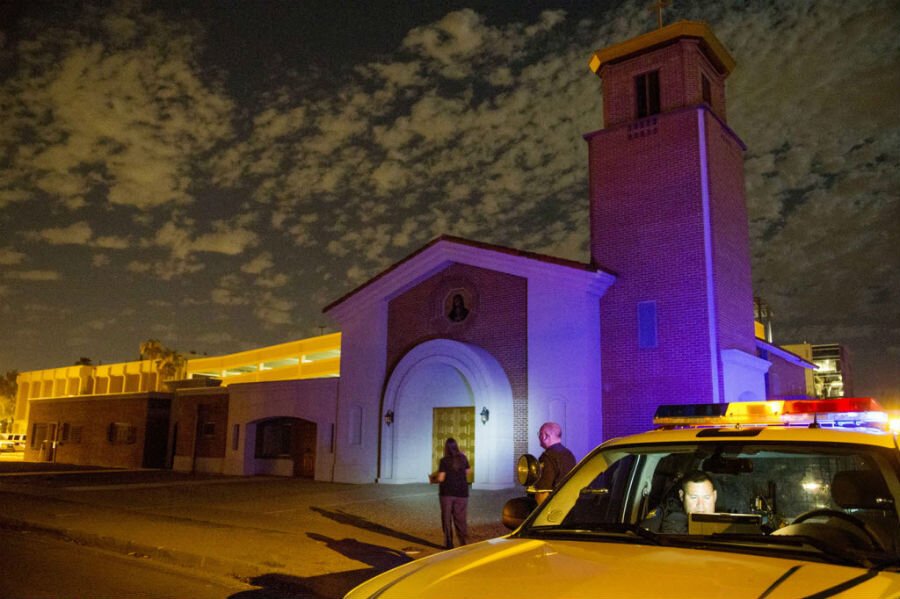Priest killed: How often does violence enter churches?
Loading...
The shooting of two priests at a Phoenix church is the latest in more than 780 deadly attacks in US places of worship in the past 15 years.
Phoenix police responded to a call about a burglary at Mater Misericordiae (Mother of Mercy) Mission shortly after 9 p.m. local time on Wednesday and found two badly injured priests in the rectory, police say. The Rev. Kenneth Walker later died at the hospital and the Rev. Joseph Terra is in critical condition.
Investigators have yet to determine if robbery was the motive for the assault, according to Phoenix Police Sgt. Steve Martos.
Robbery is one of the leading causes of deadly attacks in places of worship in the United States, according to statistics compiled by church security specialist Carl Chinn, who is based in Colorado Springs, Colo.
"Criminals tend to make these things up in their minds that the church is really rich," Mr. Chinn says. "Maybe they have been to church one or two times and seen offerings taken up."
Chinn began tracking deadly incidents on religious property a few years after he was taken hostage by a disgruntled gunman in 1996 while working as a building engineer for Focus on the Family, a Christian ministry based in Colorado Springs. The gunman eventually released the hostages unharmed and surrendered to police.
There were 781 deadly attacks on church properties between when he began rigorously cataloging incidents on Jan. 1, 1999, and when he last updated his database on Jan. 11 of this year. (Chinn says he typically waits for law enforcement to complete its investigation of an incident before posting it to his site.)
“I quickly realized that there was no clear definition as to how much of a problem this was,” he says. "I would hear news stories that would say something like, ‘This was the 5th church shooting in 10 years,’ when I had been cataloging a whole lot more stories than that.”
In the years since that fateful day at Focus on the Family, Chinn has encouraged religious institutions to implement emergency planning procedures.
“Churches tend to have a mentality that ‘God will protect us,’ or ‘If something happens to me, it must have been my time,’ ” he says. “That’s OK to say about yourself, but that’s not OK to say about your children and your church.”
As a Christian, Chinn says he does believe that God is there to protect His flock, but insists that church leaders have an obligation to take certain precautions to protect their parishioners.
On Dec. 9, 2007, a gunman stormed the New Life Church where Chinn worships in Colorado Springs, after going on a shooting spree at a missionary training school near Denver. The shooter, a former missionary student, had killed four people before a member of the church’s security team fatally shot him.
Fifty years ago, these kinds of incidents were almost nonexistent, Chinn says.
“We had never had a mass murder at a faith-based organization in the history of the United States until 1963, when four girls were killed in the bombing at the 16th Street Baptist Church in Birmingham, Ala.,” he says.
Three former Klu Klux Klan members were later convicted of murder for the bombing.
Since then, there have been a dozen mass killings, which the Federal Bureau of Investigation defines as four or more murders during a single incident, at religious institutions, Chinn says.
Chinn has not seen much evidence indicating that these mass murders, or isolated incidents, stem from any targeting of religious groups for their beliefs. He instead points to an erosion of respect for religious institutions.
“There was a time when there was a certain amount of respect for faith-based organizations. There was a time when somebody wouldn’t even think about robbing a nun, a priest, or a pastor,” he says.
At the same time, would-be shooters could be starting to run out of what Chinn calls “soft targets.”
“Throughout the United States, we have seen a hardening of targets. When something like Columbine, 9/11, or the Fort Hood shooting happens, we harden defenses of those targets,” he says.
“We may have hardened our targets, but the ratio of criminal mentality simply hasn’t gone down,” he says.
• This report includes material from the Associated Press.






